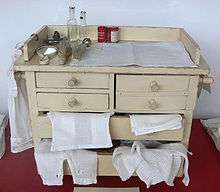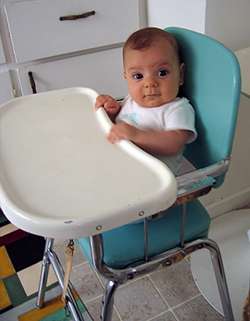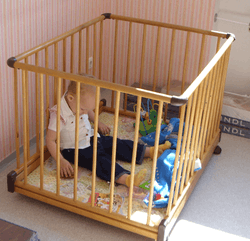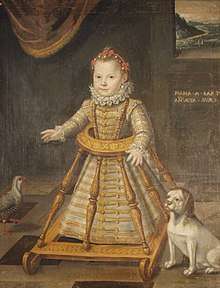Baby furniture
Baby furniture refers to furniture created for babies. It is often used to help the parents of the baby keep it safe and comfortable in the home. Before baby furniture, parents would sleep with their children in their own beds, which could be dangerous for the child. Eventually, infant beds started to be built with the child's safety in mind; the intention was to keep the baby from rolling off the bed, so mangers and bassinets were created. Over time, more furniture was created with the infant's safety in mind, and there are several types and functionalities of these. Typical pieces include an infant bed (such as a crib, bassinet, or cradle), changing table, high chair, playpen, baby walker, and toy chest. Products, features, and costs vary between countries and have changed over time. Safety is of paramount importance.[1]

Safety Procedures for Changing Tables
Many authorities state that the best way to prevent a child from falling from a changing table is to modify the table. This includes guardrails that are at least two inches on all sides, concave changing surfaces, and safety straps. Authorities also recommend keeping all necessary supplies within arms reach and to inspect the changing table before placing the child on the table. It is also important for parents to utilize safe procedures, such as proper lifting technique and using height-appropriate changing tables.
Safety Procedures for Strollers
Strollers (also known as push chairs or buggies) are a mean of transportation for infants up to around the age of 3 or 4. Variants of strollers include twin strollers as well as triple strollers. Strollers come typically with multiple functionalities including an umbrella like roof to prevent a large amount of sun to enter the stroller, the ability to detach the seat and become a car seat, the ability to fold for ease of transportation by car, and more as new designs and features are being created.
.png)
.png)
Gallery
- Bassinet with netting
 High chair
High chair Playpen
Playpen Toy chest
Toy chest Baby walker
Baby walker
References
- Steorts, Nancy Harvey (1 June 1999). Safety & You. Syracuse University Press. pp. 72–. ISBN 978-0-8156-0569-0.